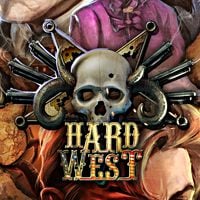Hard West Review – the Polish take on XCOM?
Hard West is not afraid to take up the glove dropped by XCOM and shows that a digital narrative can be something else than an endless festival of action and explosions. Still, this doesn’t mean it’s perfect.
The review is based on the PC version.
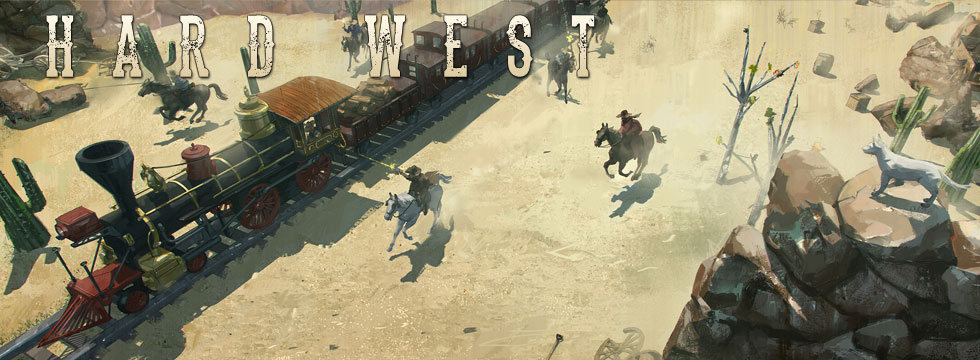
- brutal, dark atmosphere;
- very good and rather fresh combat mechanics;
- the narrator’s voice;
- background music is catchy;
- diversified weapons;
- “story collection” type of narrative;
- well-written texts which fire the imagination,
- interesting card mechanics;
- satisfying combat…
- …albeit it may be too easy for veterans of the genre;
- unbalanced difficulty level;
- the creators could have chosen other games to compare their work to;
- the ending could have been more surprising;
- the minimalistic narrative (almost no cutscenes, lack of spoken dialogue, one narrator, lots of text) may not be to everyone’s taste;
- numerous little issues.
The relatively young Creative Forge Studios have decided to make something big – a turn-based strategy game, featuring an explorable Wild West setting, RPG elements, and the supernatural. This idea was enough to convince several thousand people to back the game on Kickstarter. Let’s see if their trust was well placed and the game is worth your hard-earned money,
First, I need to clarify one thing – Hard West is a difficult game to rate; for every strength the game has, there are several smaller weaknesses. The key to understanding this production is to be conscious of the narrative form it chose to deliver the story. Modern trends focus on the “cinematic” approach – Hard West does not; Its storytelling is more akin to a book – a genuine piece of literature – than a movie. That’s why there are so few in-game cinematics, and the plot is presented through text (and lots of it). You could say it’s a simple but effective solution that’s also easy on the budget (a.k.a. cheap), as is the solitary in-game voice of the narrator. I say it’s a strong indication that Hard West is trying to use the narrative to break off from the mainstream, focusing more on the unique storytelling manner, which – what is essential – plays to the strengths of the story and atmosphere depicted in the game.
The devil made me do it
We control as many as 6 characters; two among them – Warren and his father (whose actual name, what is significant, remains unknown) could be said to be the game’s main characters, taking part in four scenarios constituting the game’s main plotline. The other four scenarios show the events from other perspective, each of them as a separate story somehow connected to the game’s central theme. The structure of the narrative resembles a collection of short stories, a structure very seldom used in video games. One exception would be the Might & Magic: Heroes series, which was a major inspiration for the creators of Hard West in terms of mechanics as well.
I won’t be revealing too much when I say that it’s the devil who is pulling the strings. From the very first moment we get the feeling that he’s the one responsible for everything that happens to our party. At the same time, he is the narrator of the story, addressing both the characters and the player This solution really helps the players identify themselves with the characters - something that is quite hard to pull off in a strategy game where you control several characters. First and foremost, however, we are unable to shake off the feeling that we are being led by the nose, and everything was orchestrated by the narrator – the devil himself.
The devil’s work is, supposedly, also the reason why the Wild West, both fictional and historical, was overflowing with bloodlust. CreativeForge distance themselves from the vision we know from the Western movies and depict not only the physical brutality, but also the brutality and dark corners of the human souls – to what degree can they possibly extend. The creators achieve this with subtlety, textual descriptions that can stir the player’s imagination to great effect, and sometimes the story gets literal – like when treating the metaphor of the demons in human soul as anything but. It may seem infantile, but its lack of obtrusiveness not only prevents it from getting in the way - it actually helps. The story is good, it has a clear message, and manages to avoid getting ridiculous.
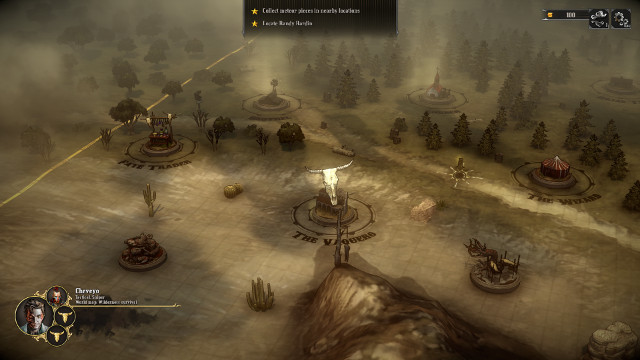
He who sups with the devil
Having a well-constructed plot is half the battle, but in spite of the interesting scenario and well-thought-out setting, CreativeForge’s work sometimes trips on gameplay mechanics. The game consists of two main elements – map exploration and tactical combat. The creators clearly made a mistake when comparing their own work to two very recognizable titles – the game was advertised as a combination of combat mechanics from the latest XCOM and the exploration from Heroes of Might and Magic series. There are some similarities but not nearly enough to call Hard West a clone of either of these games.
Every scenario begins with a plot-justified skirmish, after which we are taken to the world map, where we can manage our team, buy equipment, and complete quests, facing another round of combat from time to time. Combat also constitutes for a scenario’s finale, giving us a summary of the plot and concluding any problems the heroes had. Overall, we get 3 to 5 skirmishes for every scenario. Additionally, every story features a unique submechanic (i.e. gold mining or the addition of survival elements, forcing us to search for food for our party).
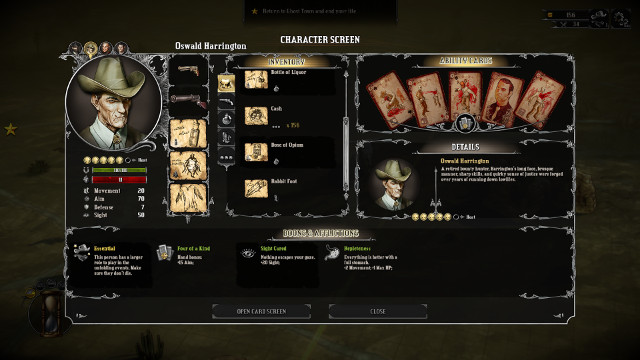
Through hell and high water
We explore the map as a team. It cannot be split to visit several places at the same time, but it’s not necessary to do so, because neither does the exploration use any kind of movement points nor are we in a hurry, rushed by some kind of timer (although it happens on rare occasions). This is the first and foremost argument to render the comparison to the Heroes series invalid. Furthermore, our means of interaction with the environments differ substantially as well – when we visit different locations, we don’t capture resources or gain skill points as in the now Ubisoft’s franchise. Instead, every location is a mini-gamebook, which allows us to achieve different results, and brings an unavoidable element of risk to the exploration. More similarities can be drawn between this game and the recent Renowned Explorers than Heroes. While we’re at it, the creators of Hard West could use some ideas employed by the former, for example character abilities and skills could influence the action in the abovementioned gamebook encounters.
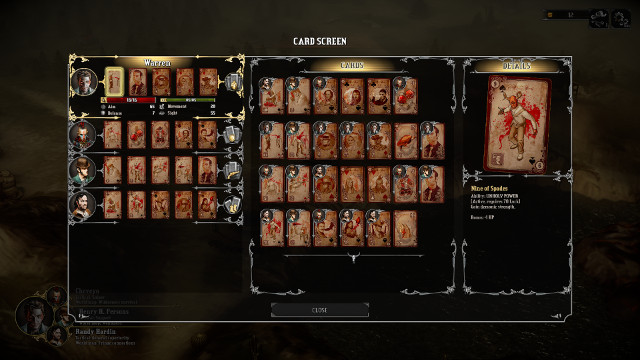
Although the comparison itself was misguided, we find out soon enough that the employed mechanics works surprisingly well and is quite engaging. The descriptions are very suggestive, and I get the feeling that they could possibly have more impact than even the most hyperrealistic cut scenes delivered by the AAA league. There’s quite a good number of choices and side quests, making 100% completion of a scenario not as easy as one would think. The interactions bring us decisions which yield either instant (character stat modifiers or weapons) or somewhat delayed (handicap or increased number of enemies) changes to the gameplay. However, I didn’t notice any truly long-term consequences or plot changes stemming from them. Luckily, the consequences with immediate outcomes provide sufficient feeling of participation in the story to rate this element as a “pro” rather than a “con”.

Such thing can hardly be said about submechanics, contributions of which to the game – although interesting - are slightly lacking. There’s no real challenge in them – the survival elements I mentioned before require barely an effort to survive, and the gold mining from another scenario is just as easy. Makes for a nice diversion but not much else. The team management offers more, albeit perhaps still too little to some of you – every character has two weapon slots, two slots for consumables to be used in combat, and a single slot for clothing providing a passive bonus to character stats. That’s not much, but when you think about the fact that we acquire a tremendous amount of various gear during a scenario it turns out that this limitation not only adds depth to the tactical aspects of the game but also provides the player with additional dilemmas. There’s enough room left for thinking and strategy when we have to assign skills to our characters. We do this using a deck of cards offering unique perks and stat bonuses. The thing is, if you can combine them to form one of the poker hands, you get additional benefits – sometimes very compelling, and including things like health regeneration. The characters are classless. What determines their effectiveness in combat are stats, cards, and equipment; the latter two being the most important. Building a good team can take a lot of time, but it’s one of the most entertaining elements in the game.
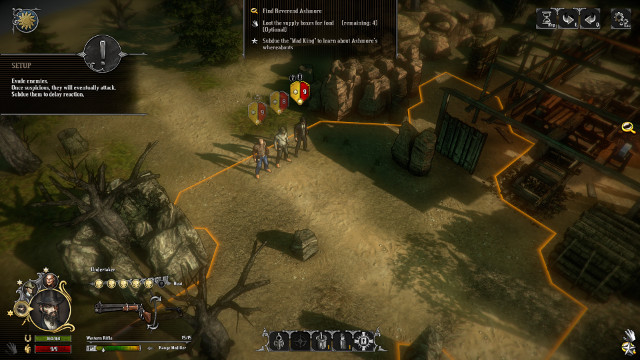
In the line of fire
Suggesting that Hard West is simply XCOM in the Wild West is another dead end, courtesy, once again, of the game’s creators themselves. First of all, the game from Firaxis emphasized a single plotline and not a collection of stories, but let’s put this one aside. The most important difference is the XCOM’s focus on base management, squad development, and completing more or less randomly generated missions. Hard West on the other hand tells a specific, largely predetermined story of a certain journey. The terrain and maps we see during gunfights have been prepared by the creators, and are not procedurally generated.
CreativeForge offer us 40 skirmishes in total and numerous, diversified arenas, albeit you have to remember that it’s still the Wild West – the decorations remain mostly the same. Enemies, unfortunately, are basically reskinned models with different weapons and a varying number of hit points. Even the demonic forces fail to introduce some significant diversity. That’s one thing Hard West should have learned from Firaxis’ sci-fi game. One more thing would be the destructible environments, because it would seem that the only breakable thing in the Wild West is the window glass.
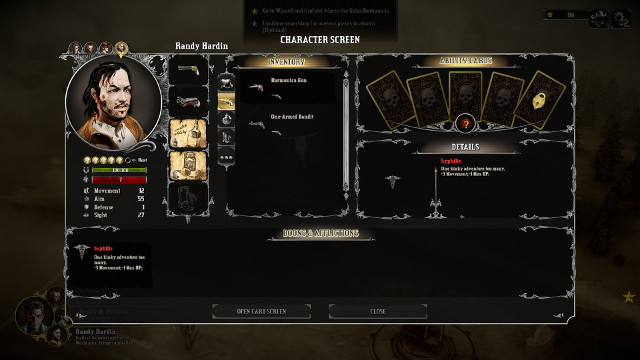
What hurts me the most, however, are the terrible AI and the poorly balanced difficulty level. I felt the most comfortable on the normal difficulty, although some fights were too easy; hard difficulty, on the other hand, nearly drove me crazy with one fight, was devoid of all motivation and grit for the rest of them. Furthermore, the enemy’s actions sometimes leave you wondering – the enemies can either walk straight into bullets, or shut themselves in a house and stay there; any kind of coordinated offensive action is rarely seen, in spite of their obvious advantage in numbers.
I found the lack of a manual save game option to be a good handicap. Our quest is saved automatically before combat, after combat, and can additionally be saved anywhere on the world map. The thing is, we cannot load the game before things like an important decision or half-way through a battle. Our choices are final within a scenario, and a single mistake during combat could cost us a restart. This solution works and adds an unavoidable element of risk to the gameplay. If you’re up for the challenge, you can select the option that will force you the restart the scenario if any of the key characters dies.
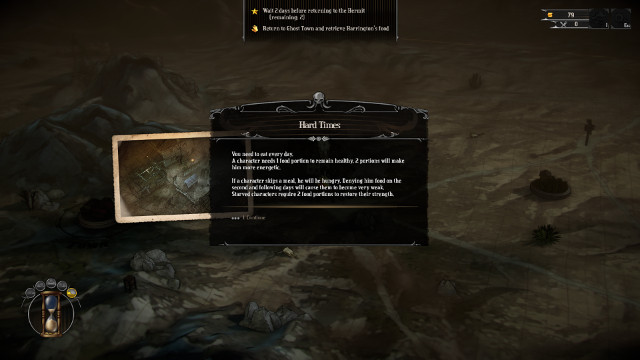
The devil is in the details…
Hard West has many small problems, but they seem to be there due to an oversight rather than the incompetence of the game’s creators. The list includes things likes dead bodies clipping through walls or repeating dialogue lines. Sometimes an enemy is marked as hidden, when he’s standing right in front of us, sometimes we can land a shot from across the whole map, bypassing several obstacles. On one occasion, I’ve seen a bug which caused the AI to completely freeze during its turn (eventually, exiting to the main menu helped). Furthermore, from time to time I was under the impression that completing optional objectives during combat didn’t amount to much benefit. I missed the option to freely zoom in and out the camera – we can switch between floors instead. I would also like to see some useful way to compare the stats between characters.
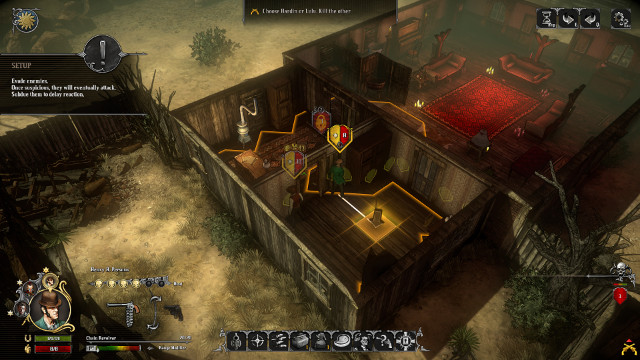
There are some bigger issues as well – many mechanics need to be learned by trial and error (an expanded tutorial or a built-in encyclopedia could have been useful), especially on the world map, which offers no introduction whatsoever. Furthermore, I was somewhat irritated by the fact that the game drops character progression from scenario to scenario where it was possible to leave it intact, by which I mean the scenarios featuring Warren. Every new scenario has to be started from square one – without cards, gear, or companions. Our options to gain access to new party members are also severely limited.
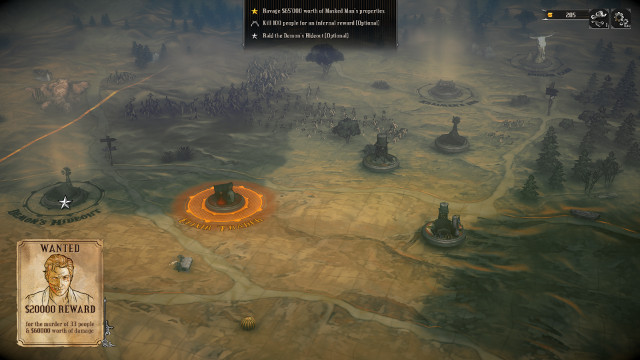
When it comes to visuals, the game doesn’t disappoint but neither does it impress. It’s simply nice, and looks a bit different than on the initial Kickstarter trailer, which featured slightly more realistic designs. The final version was enhanced with a subtle comic book-like filter. The music, composed by Marcin Przybylowicz, is catchy and it nicely matches the mood of scenes, providing tension where it is needed, and overall is one of the game’s strong points.
…but not as black as he is painted
CreativeForge’s work got me hooked particularly on two things: the fatalism and the narrative. Depicted as a collection of short, loosely connected stories, the plot avoids being artificially stretched to last several hours. Instead, it hits with short, concentrated doses. It has been a while since a game sucked me in completely from the very first minute.
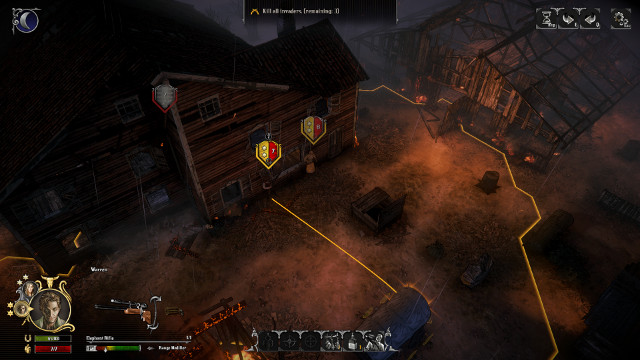
One more thing that needs to be counted in the game’s favor is the unique balance between exploration and tactical combat. Five fights in a scenario may not seem like much, but thanks to this limitation we spend comparable amounts of time shooting and exploring; in contrast, Heroes are rather combat heavy.
Completing a scenario without visiting every location and completing every quest takes around 2 hours, making it 16 for the whole game. At least 16, because taking your time to find and solve riddles, read carefully-written texts, play around with the possibilities offered by the cards, collect special weapons and items, or complete the game on higher difficulty level may easily extend the game’s life to twice the length.
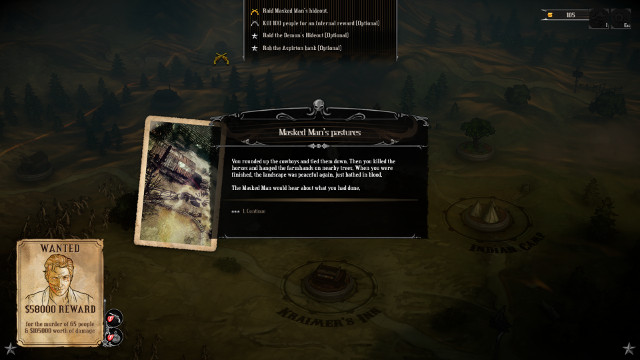
To sum things up, in spite of its shortcomings, Hard West definitely deserves your attention. It is not a wild west rendition of XCOM, nor is it particularly similar to Might & Magic: Heroes. It is a game with a well-defined, unique premise. To be honest, I’d be happy to add half a point to the final score, if not for the underwhelming ending; which is not bad by any means. I simply think that with such an interesting story the game could have easily been brought to a more daring, more meaningful completion. Therefore, I give the game a solid “seven”, but with an annotation that not everyone will like this kind of narrative – far from the typical cinematic action found in most modern games. It would be a good idea to first try it out with someone who already has it (as there is no trial version nor a demo available), and if the first 15 minutes leaves you with an urge for more, you can invest in the full version without fear.
Hard West
Hard West Review – the Polish take on XCOM?
Hard West is not afraid to take up the glove dropped by XCOM and shows that a digital narrative can be something else than an endless festival of action and explosions. Still, this doesn’t mean it’s perfect.

